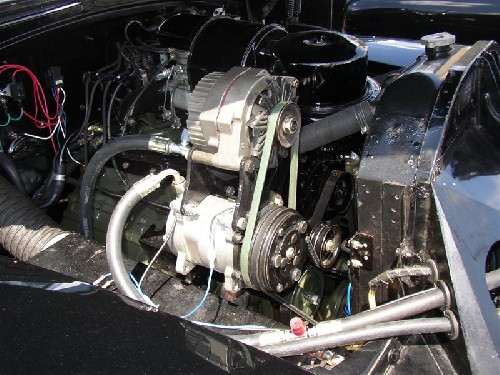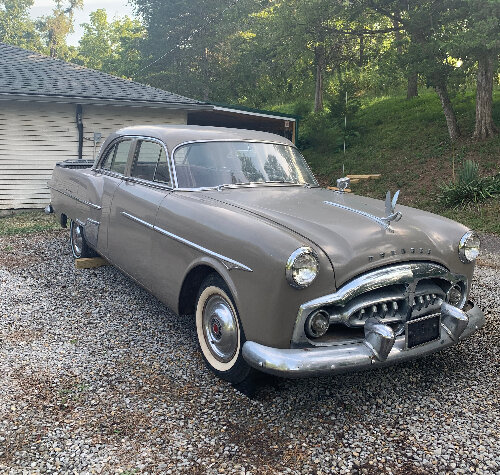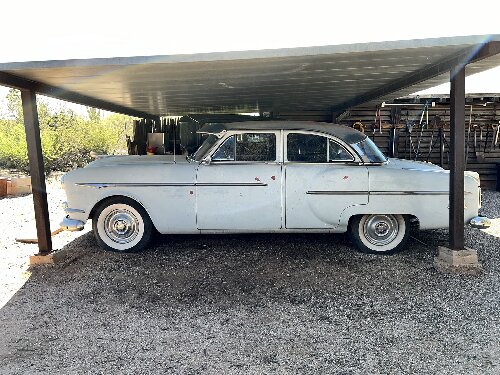|
Re: "Special" items when converting to 12 volt?
|
||||
|---|---|---|---|---|
|
Just can't stay away

|
The old Cadillac site DID have a lot of discussions on 6 volt / 12 volt / AC compressor topics, but it reached no wonderful conclusions on any of them, EXCEPT ONE:
There was ONE innovative, MAYBE practical solution, actually in use on a real old Cadillac, where the car had: - its stock 6 volt generator charging system - a 12 volt AC compressor driven mechanically from the balancer like normal EXCEPT with a dual-belt pulley on the compressor - a 12 volt battery placed remotely in the car - a 12 volt alternator driven off the second groove in the compressor pulley! This way, the 12 volt battery provides power to the 12 volt compressor clutch, AND whenever the AC compressor is running, the alternator is also turning, providing power to the 12 volt battery to charge it! In addition, this minimizes total drag on the engine, as the 12 volt alternator is running ONLY when the AC compressor is running. Finally of course, the 12 volt alterator also powers the 12 volt fan in the HVAC ssystem, and any other 12 volt accessories desired. Pretty slick. Jim G
Posted on: 2008/8/27 18:10
|
|||
|
||||
|
Re: Not what you'd expect
|
||||
|---|---|---|---|---|
|
Just can't stay away

|
I just today received a complete steering wheel from someone, from which I plan to harvest a few parts to replace mine. It's 18 inches in diameter. I weighed it on the postal scale.
It weighs over 8 pounds! Jim G
Posted on: 2008/8/26 18:42
|
|||
|
||||
|
Re: Rear Springs
|
||||
|---|---|---|---|---|
|
Just can't stay away

|
Delores is the gal at Antique Auto Battery. That company makes authentic looking but modern insides batteries.
There is a big difference between the 6/12 and 12/6 batteries they offer: The 6/12 type of battery is intended for use on a car with a 6 volt charging system (6 volt generator or alternator). Because the charging system is only 6 volts, it charges both halves" of the battery via a special connecting device that connects the two sides of the battery. You get 6 volts off one power terminal and 12 volts off the other, as needed. The 12/6 type of battery is intended for use on a car with a 12 volt charging system (12 volt generator or alternator). Because the charging system is 12 volts, it charges both sides of the battery (the 3 cells that make the 6 volts and the other 3 that add 6 more volts)all at once. Delores says that the two halves can get into differing states of charge if one side is uised a lot more than the other, but if necessary,a 6 volt charger can be connected across either side. We REALLY should move this discussion to the "special 12 volt conversion" thread I started, rather than this "new springs" thread! :) Jim G
Posted on: 2008/8/26 9:42
|
|||
|
||||
|
Re: "Special" items when converting to 12 volt?
|
||||
|---|---|---|---|---|
|
Just can't stay away

|
BigKev: Wow. I had no idea That getting a heavier 6-volt capable wiring harness would add THAT much cost over a typical universal GM 12 volt harness.
I knew that the ONE brand was very costly, but assumed that they are just very very high quality and feature laden. Are you saying that there are no inexpensive universal 6-volt harnesses out there? THAT does put a real damper on choices of what to do. Jim G
Posted on: 2008/8/26 9:31
|
|||
|
||||
|
Re: Not what you'd expect
|
||||
|---|---|---|---|---|
|
Just can't stay away

|
Rusty O'Toole: I don't own a Packard V8 engine, but do own a GM LQ9 6.0 liter out of a Cadillac Escalade, that has already been cammed, has MSD electronic ignition fired off the stock reluctor ring, and has had the fuel injection replaced by an Edelbrock performance manifold with dual 4-barrel carbs, all polished for effect.
The Packard V8, despite its non-SAE-compliant "gross" hp rating, would be plenty strong enough, and would certainly be an easier project, since, as you point out, the '55 used the same body (disguised a bit), BUT I don't have one. You use what you got whenever you can and money is tight . . . The GM LS series engine is also serviceable anywhere, and very reliable - the LS series V8s are used in all GM V8 vehicles except Cadillac Northstars, including in all the pickup trucks, so the bugs were worked out long ago. And, if the insanity strikes you, Magnacharger makes packaged supercharger kits for them that get them to about 600 crank hp while still being incredibly reliable (and 16 inches of vacuum at idle). Jim G
Posted on: 2008/8/26 8:40
|
|||
|
||||
|
Re: Not what you'd expect
|
||||
|---|---|---|---|---|
|
Just can't stay away

|
BigKev: You are right - I have never yet "registered" my Packard on the forum. I'll take a look at what is involved and try to do that asap.
I have a 1952 Packard 200 Deluxe, Model 2562, 4-door sedan. Jim G
Posted on: 2008/8/26 8:32
|
|||
|
||||
|
Re: "Special" items when converting to 12 volt?
|
||||
|---|---|---|---|---|
|
Just can't stay away

|
On another thread, Bob1951 has suggested that perhaps two separate 6 volt batteries could be used, and charged by having them in series.
The two "conventional" batteries would cost less than the one "12/6" battery, and would be easier to replace anywhere too. Delores told me (I think, if I understood correctly), that with the 12/6 battery, you can indpendently charge each half of the battery with a 6 volt charger, if one side gets run down because of more use than the other. So, the answer COULD be "yes". I don't have a clue on that. Bob is saying he might be able to find out. Jim G
Posted on: 2008/8/25 20:55
|
|||
|
||||
|
Re: Rear Springs
|
||||
|---|---|---|---|---|
|
Just can't stay away

|
Bob: If you could find out, I would appreciate it.
The two "conventional" batteries would cost less than the one "12/6" battery, and would be easier to replace anywhere too. Delores told me (I think, if I understood correctly), that with the 12/6 battery, you can indpendently charge each half of the battery with a 6 volt charger, if one side gets run down because of more use than the other. So, the answer COULD be "yes". Jim G
Posted on: 2008/8/25 20:53
|
|||
|
||||
|
Not what you'd expect
|
||||
|---|---|---|---|---|
|
Just can't stay away

|
This is a posting about how things aren't always as they seem, and how opportunities lie where you would never think of looking for them.
I'm naturally posting it on the two websites where I spend the most time these days: The Packard Forum and the SSR fanatic website. The Packard guys and gals will probably appreciate it because it is so Packard centric. For the SSR Fanatics - it might be a bit of a stretch. It's a technical topic, but those of you on the SSR site might find it offensive because it's not directly SSR-centric. If so, go ahead and evict the posting from the site - I know the literal rules and I won't cry. I just thought some of you might be interested in it, as I know many of you have pretty substantial car collections, you favor hot rods, and you might find the information useful and even inspiring. Take a look at this photo of my 1952 Packard "daily driver" (yes, I KNOW that's a good laugh): [IMG]http://i252.photobucket.com/albums/hh16/JimGnitecki/Packardprofilewithoutrearfactorybum.jpg[/IMG] Be honest - what would you guess it weighs? Here are some specs to help you: Length: 213 inches (17 ? feet) Width: 78 inches Height: 62 1/2 inches Wheelbase: 122 inches Engine: Cast iron inline 288 cubic inch flathead 8 cylinder (weight with clutch,manual transmission, and overdrive unit is 895 lb) Comments on build approach: There are 4 very substantial sedan style (full perimeter metal frame) doors with 8 (yes 8) windows, and all the hardware associated with that. The left and right front signal/parking lights weigh in at 4.8 lb. The engine cooling fan is 18 inches in diameter and all metal. Seating capacity: 6 Truck capacity: 32.5 cubic feet (compare this to any modern car you like - it's HUGE) Payload (people & cargo) capacity (GVWR minus vehicle weight): In 1952, The Federal Government did not yet require GVWR stickers on every vehicle, but since the car was designed to haul 6 people and their luggage, I think we can assume payload was pretty substantial. Frame: Heavy duty full perimeter rails PLUS x-frame - makes a modern pickup truck frame look spindly Sheet metal: I don't know what specific gauge sheet metal was used here. But, the modern practice is to use a lot of 20 or 22 gauge sheet metal. When this Packard was built, the normal practice was more like 16 or 18 gauge. To give you a feel for the difference: 16 gauge is 0.06" thick while 22 gauge is 0.03" thick - half the thickness and half the weight. 16 gauge steel weighs 1.22 pounds per square foot. True documented story: While Speed Age's road tester was testing the 1952 Packard in 1952, sitting at a traffic light, he was hit by a runaway fuel tanker truck. The car was declared a total loss due to sheet metal damage, BUT (a) the tester was unhurt despite the lack of seat belts or air bags, and despite the car being spun completely around, and (b) the car was DRIVEABLE after the accident despite being "totaled". This is a BIG car that can be expected to be heavy. My last long-term daily driver, my 2004 SSR, had the following specs by comparison: Length: 191 inches (almost 2 feet shorter than the Packard) Width: 78 ? inches (1/2 inch wider than the Packard) Height: 64 inches (1 ? inches higher than the Packard Wheelbase: 116 inches (6 inches shorter than the Packard) Engine: LS series aluminum V8 (weight with clutch and manual transmission is about 644 pounds, or 251 pounds lighter than on the Packard) Comment on build approach: Many of the exterior body pieces are plastic and some are retained by Velcro strips. There are only 2 doors, and it's a "hardtop" with NO door metal above the door beltline. The engine cooling fan is plastic. Seating capacity: 2 (4 less than the Packard - two 18" wide buckets versus two very wide bench seats) Cargo capacity: 22.5 cubic feet (10 cubic feet less than the Packard) Payload (people and cargo) capacity (GVWR minus vehicle weight): 1328 lb The SSR weighs 4639 pounds before fuel. Here are some other interesting vehicle weights (from Road & Track Magazine): A Chrysler 300M weighs about 3700 lb. A BMW M3 Coupe weighs 3650 lb. A Cadlillac CTS weighs 3980 lb. A Mustang GT weighs 3615 lb. A new Challenger weighs 4145 lb. A Pontiac G8 GT weighs 3910 lb. A Lexus IS F (the new "performance" Lexus) weighs 3825 lb. The LIGHTEST of all Mercedes models weighs 3630 lb. with a V6 engine Even a Honda Accord is 3545 lb. A Nissan 350Z sports car weighs 3550 lb. A 2008 Corvette, with its intense and costly focus on weight reduction, weighs 3285 lb. I weighed my Packard carefully on a set of 4 computer-controlled racing scales. It weighs 3971 pounds with 15 gallons of fuel aboard, and 3879 pounds before fuel. How can that be? Well, it IS a pretty simple car. It's large, but it houses a lot of usable "air space". It was the bottom end of a luxury car line, so it lacks most bells and whistles (manual EVERYTHING). It was instead simply built to a very high quality standard versus gadget and option level. For example, after 56 years, all 4 doors still don't sag and still close with a reassuring "thunk". It gets better. The weight distribution, left versus right side of the car, is perfect to within 1%. The car IS front-end heavy though due to that heavy engine, and comes in at 56% front / 44% rear. However . . . I can't help myself here. My mind just naturally wanders to creative places. Suppose - just supposing now - you replaced the engine, clutch, transmission, and overdrive with a modern GM LS series 6.0 engine plus 700R4 auto OR 6-speed Tremec (your choice- virtually exact same weight), the weight goes to 3632 pounds and the weight distribution becomes 53 front / 47 rear. The power is at LEAST 400 crank hp, and 500 crank hp naturally aspirated is pretty simple, since this car's AMPLE engine compartment (thanks to that huge inline 8 engine) will hold the LS engine, good headers, and a HIGH intake rather easily I think, and LS series performance cams all target 450 to over 500 hp. Yeah, you'd want to change that rear axle to something with posi-traction, but the new axle would likely be same or lighter weight (no kidding - the stock axle on my '55 pickup is same weight as a Ford 9 inch). Think ultimate sleeper: Big substantial looking early 50s 4-door sedan, but only 3632 pounds and 400 to 500 crank horsepower. Think engine compartment size that makes the compartment in my '55 SLURP pickup project truck look SMALL in comparison, so easy to work in and room for steering and headers, and good cooling air circulation. The frame rail spacing is so wide, I'd be surprised if you need to move the steering at all to get that LS V8 in there. Think about the surprise factor on the street, of a really big 4-door black sedan with a power to weight ratio close to that of a Corvette, and way better than that of a Mustang or new Challenger. I think this could spell fun. Heck, I already have a "suitable" (6.0 liter, with Edelbrock Air Gap manifold and TWO 4 barrel carbs) engine and transmission (courtesy of my '55 pickup SLURP project), and I just installed a brand new 3-core radiator in the Packard. I'd need basically boltable custom motor mounts and a driveshaft, to make it driveable . . . . The gas mileage would probably IMPROVE (ok, I'm rationalizing). My computer performance modeling software predicts a quarter mile time in the low 12s, and a top speed north of 150, despite the awful aerodynamics, with 1st gear good to 45 mph, 2nd gear good to 85, and under 2000 rpm at 60 mph in overdrive. How could I do this practically without being "vehicle-less" for weeks? Remember, I bought the Packard to have a daily driver while the '55 pickup project is in progress! I don't want to instead supercharge that beautifully smooooooth inline flathead 8. It's perfect as is for what it was designed to do. You don't mess with perfection. The responsible side of me is saying "Why are you even THINKING about something so stupid? This is your replacement daily driver for the daily driver you ALREADY disassembled and made undriveable." Help me here. The temptation is soooooo strong. The dark side is calling me. Jim G
Posted on: 2008/8/25 20:47
|
|||
|
||||

 (79.99 KB)
(79.99 KB)







